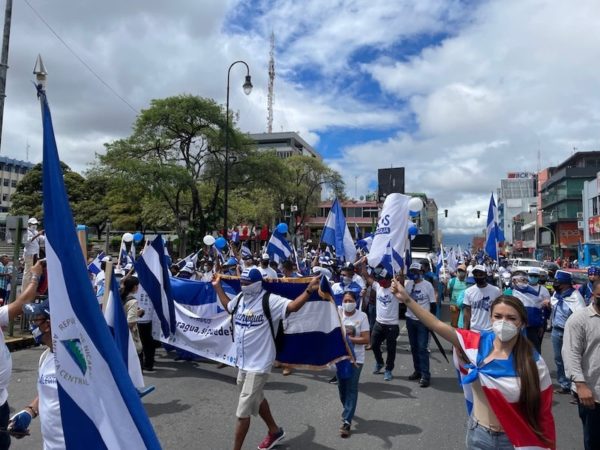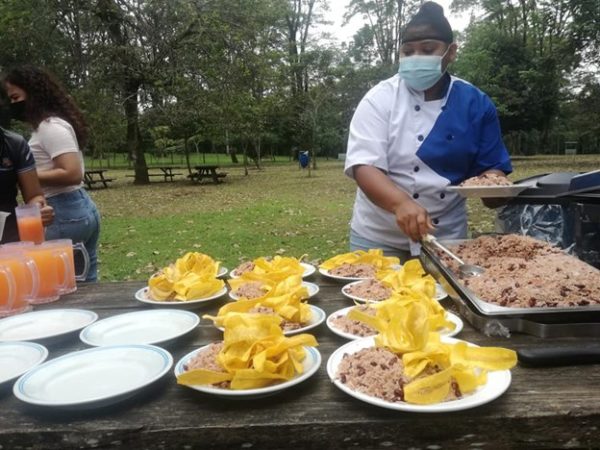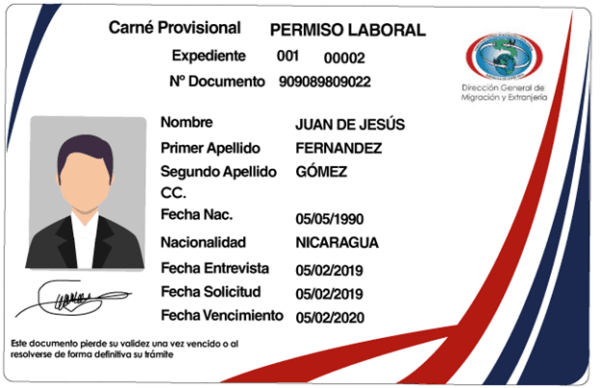The Lives of 160,000 Nicaraguan Asylum Seekers in Costa Rica
“Between uncertainty and resistance”

Although an ID card marked “asylum seeker” conveys legal immigration status, it doesn’t guarantee this population an adequate and decent integration into society.
By Katherine Estrada Tellez (Confidencial)
My name is Walter Enrique Orozco Martinez, asylum seeker with the DIMEX ID number of xxxxxxx. The object of the present letter is to formally request an appointment to review the status of my application for asylum, and the current status of my case, given that 12 months have now passed since my eligibility appointment and I would like to know if there’s yet been any response to my case.
HAVANA TIMES – Thus reads the letter that Enrique Martinez, a 24-year-old Nicaraguan, sent on July 26 to the Refugee Unit of the Costa Rican Office of Immigration and Foreign Affairs. Martinez went into exile on November 5, 2018, after suffering political persecution in Nicaragua for being part of a student movement. Two days after arriving in Costa Rica, he applied for asylum. He had to wait three years – until June 2021 – for his eligibility appointment with the authorities. More than a month has now passed since that interview, yet he still hasn’t had a response.
Like Martinez, hundreds of Nicaraguans have been waiting more than a year without receiving any response from the authorities as to whether or not they’ll grant them international protection. This is also the case of Eveling Cunningham, who left Nicaragua in June 2018, together with her three daughters and her ex-husband. They had their eligibility appointment in October 2019, and nearly three years later, there’s been no response. As such, they continue to hold only the status of asylum seekers.
On April 18, 2018, the “April Rebellion” erupted in Nicaragua, when hundreds of people went out on the streets to protest a change to Social Security ordered by the Ortega regime. The reform would have affected the retirement pensions of thousands, and the seniors, plus youth who were in solidarity with them, demonstrated to show their displeasure.
Those peaceful protests were brutally broken up by the government’s shock troops, causing great indignation among the population. That, in turn, led to massive demonstrations demanding an end to the repression and to Ortega’s rule. From then on, the state repression only intensified. The resulting conflict ended in more than 350 deaths, thousands of wounded, hundreds of political prisoners and tens of thousands of Nicaraguans fleeing across the border to the neighboring Costa Rica, in search of protection from persecution and threats of both jail and death.
From that date until July 2022, a total of 163,333 Nicaraguans had applied for asylum in Costa Rica, comprising 92% of the total requests for asylum that the Costa Rican immigration authorities have received. Added to this are the estimated 50,000 requests from people who have scheduled an appointment to fille an asylum request, but who are still waiting for a date and time to formalize their application.
During that same period, the Costa Rican Immigration Agency has granted refugee status to 4,260 Nicaraguans. In 2019, 943 cases were approved; in 2020, 2,408 requests were approved; in 2021, the number shrank to only 215 approved requests; and in this first part of 2022, international protective status has been granted to a little over 700 Nicaraguans. In other words, of the total number of requests, only 2.6% have received a positive response. How are the rest of the 160,000 Nicaraguan asylum seekers getting by? “Between uncertainty and resistance,” Martinez confesses.

Life with an asylum seeker’s ID card
“With the ID card of an asylum seeker, I feel limited,” Eveling Cunningham comments. In Nicaragua, she had been studying at a culinary academy in the capital, seeking to master national and international cooking. She also had her own small restaurant in the Roberto Huembes market. Before going into exile, she sold all her belongings: her vehicles, the industrial equipment from her business, and her household furnishings. With that money, she began a new life in Costa Rica.
“We tried from the beginning to establish a business, but at that time the [asylum seeker] ID wasn’t valid like it is now. The banks didn’t recognize it, nor the businesses, nor even the State institutions,” she recounts. Cunningham began to work cleaning houses, while her former partner did odd electrical jobs and also worked as an Uber deliverer.
They managed to save up, and sought help from a lawyer that was part of the Nicaraguan diaspora in Costa Rica, in order to begin a food business. “I passed my Food Handler’s Class, got the Heath permit and a permit, and that allowed me to establish my food locale. However, my ability to advance with the business is still limited,” Cunningham states.

Holding an asylum seeker’s card doesn’t allow her to apply for bank loans to invest in her business, or for buying a house. “Being a refugee seeker doesn’t offer the bank any guarantees, even though you can generate enough of an income for the payments. If I had my refugee status or residency, I’d already have qualified for a loan,” she explains.
In Martinez’ case, being a refugee seeker has also caused him some barriers in his insertion in the country. In Nicaragua, he studied Law at the Central American University, and Political Science and International Relations at the Nicaraguan National Autonomous University in Managua. He was expelled from the latter in 2018, in reprisal for having demonstrated against the government.
“I wanted to continue my studies, but being a refugee seeker in Costa Rica limited my entrance into the university. There was a lot of ignorance about the situation in Nicaragua, and part of the documentation that they required for admission were records you could only request personally in your country (of origin). I couldn’t risk doing that,” Enrique Martinez recalls.
Martinez had to take some steps backwards in order to advance. In 2019, he had to take a special class for adult students who wanted to receive their high school diploma. This involved a test of six basic subjects that are required to finish secondary school in Costa Rica. Later, he applied and was accepted at the University of Costa Rica.
He’s now in his second year of Business Administration. He’s part of a political structure called U Factorial and belongs to the University’s Institutional Commission against Discrimination, where he brings to the table topics that benefit the community of students who are asylum seekers.
“My case served as a precedent for the University of Costa Rica to make the admissions requirements more flexible for those who are seeking asylum, without putting the student at risk, and to include the category of asylum seeker within its classifications,” Martinez states.
Although both Martinez and Cunningham have little by little been toppling the barriers that for refugee seekers, they still feel their status lacks recognition from the State. “One strong demand of our political struggle is to have an approved asylum status. That gives you a sense of belonging in the country,” underlines Martinez.

Both Enrique Martinez and Eveling Cunningham indicate that having only an asylum seeker’s ID card means more time and expense for certain procedures. For example, Cunningham has a Food Handler’s Card that’s valid for five years, but in her case, she has to renew it yearly, since her asylum seeker’s ID also expires every year. For his part, in order to renew certain benefits, Martinez must periodically send a letter to the Costa Rican University’s Assistant Dean of Student Life, detailing his immigration status as an asylum seeker.
These two examples reveal some of the barriers Nicaraguans must deal with in order to be able to integrate into the country while they await the results of their application for refugee status in Costa Rica. There are other cases of professionals, business leaders, and university students who don’t succeed in restarting their lives, businesses and careers.
“I know Nicaraguans with academic degrees who’ve had to work in informal labor, doing domestic service, caring for others, or trying to start a small business, but you have no idea how hard it is to do the latter in this country,” Cunningham says.
For these two Nicaraguan asylum seekers, daily life involves coping with obstacles, amid their yearning to integrate into Costa Rican society in a full and decent way. Both are anxiously awaiting a “yes” from the immigration authorities, in order to be officially declared refugees and thus have more access and guarantees in the country.
Costa Rican authorities without a plan to speed up response times
Despite the considerable increase in applications for refugee status that the Costa Rican Immigration Agency has received from Nicaraguans, there’s no plan to speed up the response times for the over 200,000 applicants.
“At this time there’s no concrete plan on the table for the Costa Rican government to make any decisions like that,” Allan Rodriguez, assistant director of the Costa Rican Office of Immigration and Foreign Affairs, told the Nicaraguan online 100% Noticias in a recent interview.
Rodriguez also recognized in an interview for the Nicaraguan online news program Esta Noche, that the institution he works with has a limited capacity to manage that large volume of work, since nationally there are only 50 employees working in the Refugee Unit.
In another interview, this time with the EFE news agency, Costa Rican foreign minister Arnoldo Andre Tinoco warned that resources to attend to the waves of immigration they receive are limited. “Costa Rica is going to continue with their policy of humane hospitality, following the principles of asylum, but the government has clarified that their economic situation doesn’t allow them to deal with this alone – they need international economic support. It seems unjust to have to go into debt and pay interest to resolve a problem whose origin lies outside of Costa Rica,” he declared.
Meanwhile, the Refugee Unit continues with a plan to move up the appointments for first-time requests for asylum currently scheduled after October of this year. That plan went into effect in July, in collaboration with the UN High Commissioner for Refugees (UNHCR), with the target of completing at least 2,000 appointments a month. From that date until the end of August, they’ve managed to cover 3,840 appointments.
UNHCR acknowledges the slow response process on the part of the Costa Rican immigration authorities, but clarifies that the national institution is solely responsible for establishing its protocols and action plans. The UN agencies can’t tell them what the best way of conducting these processes is. “We respect the sovereignty of each country, insofar as how they carry out the processes of accepting refugees. We hope they respect due process and the rights of people who require international protection. For our part, we’ll continue offering technical consultation and cooperation to the government for the implementation of solutions, following the highest standards of protection and strictly tied to the laws,” declared Diego Perez Damasco, director of communications for UNHCR.
Possible solutions
Daguer Hernandez, a specialist in Immigration Law and former assistant director of the Costa Rican Immigration and Foreign Affairs Office, suggested that the Immigration agency focus its efforts on three possible paths to speeding up the response time for those 200,000-plus applications.
One is to create a new category or format for immigration legalization, so that people no longer have to rely on the condition of asylum seekers to legalize their stay in the country. “Those people who currently form part of the refugee seekers, but who really don’t run any risks in their country, could apply for something we could call ‘permission to work’, or ‘complementary protection’, or ‘exceptional legalization’, or whatever is deemed convenient, without having to saturate this category (of asylum seekers), “ Hernandez suggested.
The second route, he indicated, is to establish channels for prioritizing some of the interviews and applications, so these could move more rapidly. “They could ask for help from the UNHCR or from NGOs who advocate for this population,” he recommended. His third and last suggestion was to have the Costa Rican government take on the responsibility of granting the Immigration Office the necessary personnel to attend to the current and future demands.
“It’s important to note that the Office of Immigration and Foreign Affairs contributes nearly 60% more to the Costa Rican government than what is budgeted for it. Hence, if it had more functionaries and services to offer, it would produce still more earnings, in an efficient way,” Hernandez concluded.
Meanwhile, Eveling Cunningham comments that if there were an alternative way to legalize herself in the country, she’d do it, even if she had to renounce her refugee status. “I’m now establishing myself in this country, and my family and I need to be able to count on a document that makes us feel legal, without being fearful that our applications could be refused. With that, we could integrate better and with more quality of rights in Costa Rica,” she assures.
For his part, Enrique Martinez demands that the Costa Rican government invest the efforts necessary to speed up the response times for asylum applications. “We need to feel ourselves protected, at least by this country, since our own turns a blind eye to our status as citizens and condemns us as traitors,” he concludes.
This article was produced in the framework of the Communication Bridges III of the Department of Training and Composing of the Cocuyo and El Faro School. The project was supported by DW Akademie and the Germany’s Federal Ministry of Foreign Relations.





